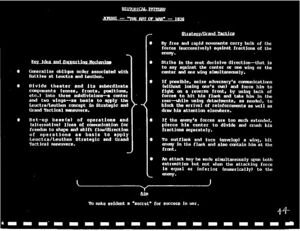Patterns of Conflict
| The works of |
| Works of John Boyd |
|---|
OODA WIKI Edition
Quantico Transcription
Okay. Jomini. The key idea and supporting mechanism. Remember, we already talked about the previous chart. Generalize the oblique order. Note this, it’s a key idea. Divide theater support components into three— He said ideally into three subdivisions: wing, two wings in the center, you can do it two wings left and right [unintelligible], but he said the basic idea is so you have some what of thinking about it. Trying to give you a mechanism so you can employ the strategic and grand tactical maneuvers. And the importance of setting up a base of operations and line of communication. Not only that, so you can shift them and shift them—I mean you can change them and shift them. So you can actually gain leverage on this maneuver. And his strategy and grand tactics.
Note this: By free and rapid movements, carries the bulk of the forces against fractions of the enemy. Those are important statements. If you’re not free and rapid, how are you going to get your strength against their weakness? You’re not going to be able to. Once again, the speed in the sense is the higher principle than the idea of concentration. He in a sense says that right in the statement. And all that Clausewitz brought out, he was trying to say together.
Okay, strike in the most decisive direction. I’ve got a caveat this one. That is to say, against the center or one wing, or the center and one wing simultaneously. Remember, I’ve got two things grouped together. Strategy and grand tactics, which are the operational level. In a strategic sense, you can go against the center or one wing because you’re spread outward. In a grand tactical sense, you can go against the center and one wing simultaneously. That’s the only caveat. Otherwise, all the other ones stack up pretty much the same. And he recognized the importance of seizing his communications. In other words, cut him off from resupply. Cut him off from support. People tend to panic when they lose their support, and start doing dumb things, and force him to fight on a reverse front. If the enemy’s forces are too much extended, pierce his center. [15:00]We saw that earlier in Napoleonic maneuver. Go out, flank, and turn their wing.
Hit the enemy in the flank and also contain him at the front. That’s Patton. Hold him by the nose and kick him in the ass. He might have read Jomini and got it out of that. I don’t know. [unintelligible] Hold him by the nose, kick him in the ass.
Note this statement: Attack may be made simultaneous upon both extremities, but not when the attacking force is equal or inferior to the enemy’s. There are too many counterexamples to that. It doesn’t stand up. Even Napoleon at Dresden pulled it off. You look at Cannae and many other of the damn things done. Just too many counterexamples of that. It doesn’t work out. But if you look at it more carefully than what he’s writing, what he’s really doing is he’s juxtaposing the double envelopment versus single envelopment. Basically, what he is saying is you can get the same leverage with less force out of a single envelopment scheme as opposed to a double envelopment. Basically that’s what he’s saying. If you look at it in a very rigid sense, that sort of holds together.
Okay. His aim was what he called “make evident the secret to success in war.” He was not trying to give you the secret of success, just trying to give you a way of thinking about it, so you can deal with these complexities, and that’s what he’s really saying, even though he uses that word.
